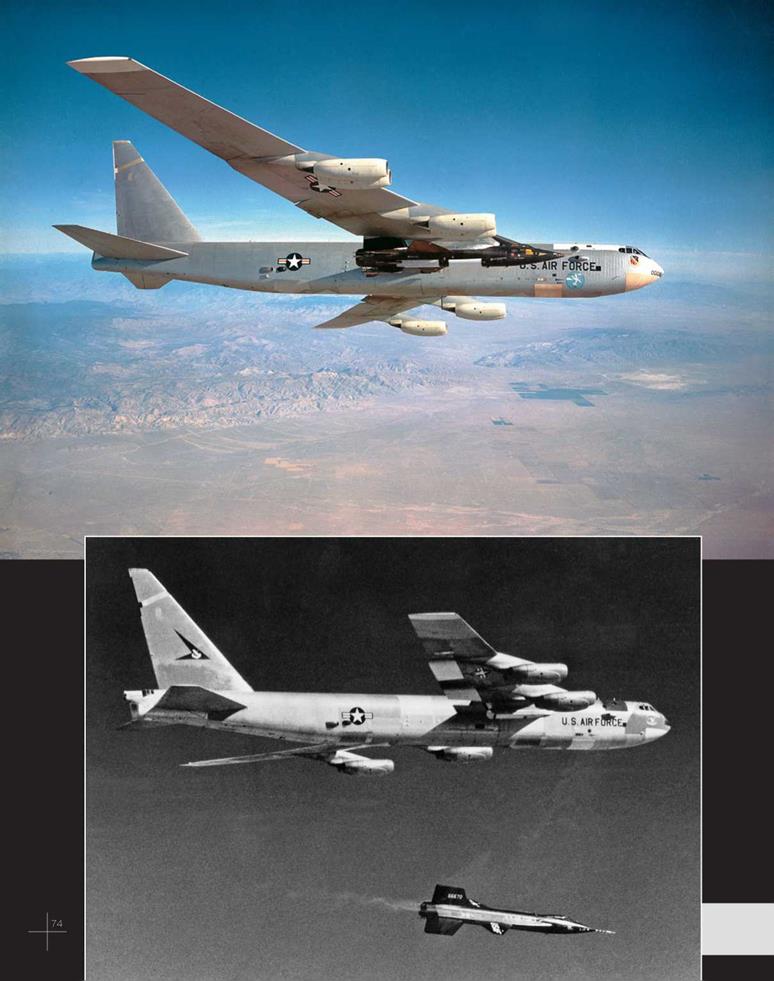THE B-52 CARRIER AIRCRAFT
The X-15 flights would not have been possible without the B-52A, which carried the airplane under its right wing. Edwards Air Force Base is huge, and it includes the whole of Muroc Dry Lake. Not only did the flights originate at Edwards, both the X-15 and its mother ship, the B-52, landed
there also, although on different plots of ground at the site. The B-52 started on the runway at zero velocity, accelerated to takeoff, and carried the X-15 to its launch position with a speed of approximately M=0.85 and an altitude of about 45,000 feet.
While the X-15 achieved a record speed of M=6.7, the first 0.85 was accomplished by the B-52 in the first phase of the flight. The B-52 also sometimes positioned the drop location as far away from Edwards as 300 miles, whereas the flight profile dictated for the X-15 to land at Edwards. The X-15 expended no fuel for such a running start, which was required to obtain the data sought by the test.
It took about an hour and a half from takeoff to get to the launch position; the rest of the X-15’s flight to its landing was an additional 10 minutes.
Both the X-1 and the X – 2 rocket-powered research aircraft were also carried aloft from


Listed below are the number of landings that took place at alternate fields, to be compared with the 188 normal landings at Rogers Dry Lake.
2 Cuddeback
1 Delamar
4 Mud
1 Rosamond
1 Silver
1 Smith Ranch
Since these were emergency fields, they had to have equipment there and personnel on site to act in case they were needed. Prior to the flights, equipment such as a fire truck with 500 gallons of water, a helicopter, firemen, an Air Force pilot to act as the lake controller, an AF crew chief, an AF doctor, an AF pressure-suit technician, and a NASA X-15 specialist were deployed. A test flight was a big operation, and a cancelation was a waste of time for many.
Edwards Air Force Base by carrier or “mother” aircraft, the B-29 for the X-1 and the B-50 for the X-2. The mechanical alterations required to the carrier aircraft were principally in the bomb bay area in order to securely hold the research aircraft and to provide a reliable launch mechanism.
The research aircraft pilots rode to the launch altitude and speed in the carrier aircraft, did the checkout before launch within the carrier aircraft, and replaced the liquid oxygen that had boiled off during the climb, all before entering the research airplane. For the X-15, the mother ship was supposed to have been the B-36, and the X-15 would have been carried to its launch position in the bomb bay opening. Some of the reasons the B-52 made the cut instead were related to differences in the availability and cost of each aircraft and the parts required for its maintenance during the flight-test program.
The B-36, then in the process of being phased out as an active bomber in the Air Force inventory, was a maintenance nightmare, whereas the then – modern B-52 was (and still is today) the main bomber for the Strategic Air Command. Moreover, the weight of the X-15 increased during the design phase, and the extra capability of the B-52 could
 еоооз
еоооз

more easily achieve the speeds and altitudes required by the data regions. Changing from the B-36 to the B-52 meant that the X-15 pilot could not ride inside the carrier aircraft. Using the B-52 meant that the X-15 had to be mounted on a pylon under the B-52’s right wing.
There was no way for the pilot to transfer from the B-52 to the X-15 after takeoff, which meant that he had to remain inside the X-15 during takeoff and for the roughly hour-and-a-half climb to position. This increased the pilot’s risk significantly. In an emergency during the launch-to – climb phase, the B-52 would have to drop the X-15 and its pilot rather than risk the lives of the entire operation’s crew. If the X-15 could be dropped, its pilot could possibly glide to a dry lakebed, or eject if the altitude was high enough. There were a number of captive flights—i. e., while the X-15 was still attached to its mother ship—where problems arose of such a nature that the launch was aborted, such as the auxiliary power unit (APU) not functioning in checkout or electrical signals not transmitting properly. In these circumstances, the B-52 landed safely with the X-15 still tucked under its wing. On such occasions, it must have seemed like a long, fruitless mission for the captive X-15 pilot. Luckily, neither the B-52 nor the X-15 pilots ever had to face such an unplanned drop.
The B-52 required numerous modifications to allow both airplanes to replenish the liquid oxygen, to accommodate the mating of the two aircraft, to assure that the B-52 had adequate control for the mission, and to assure that structural sufficiency was proper for both aircraft. (The X-15’s fuel was anhydrous ammonia, which does not boil off and does not require topping off, meaning that only the liquid oxygen required replenishment.) Twenty-seven B-52 pilots supported the X-15 flights. Two of the first were Capt. Charles Bock and Capt. John Allavie.
Above: X-15 in the process of being mated to the B-52. USAF, Air Force Flight Test Center History Office, Edwards Air Force Base
X-15 being dropped from the B-52. USAF, Air Force Flight 75
Test Center History Office, Edwards Air Force Base
The activities of the B-52 airplanes and their USAF pilots over nine years were integral to the success of the X-15 program. It was not a minor expense.










